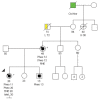Clinical and functional properties of novel VHL mutation (X214L) consistent with Type 2A phenotype and low risk of renal cell carcinoma
- PMID: 20560986
- PMCID: PMC2958253
- DOI: 10.1111/j.1399-0004.2010.01464.x
Clinical and functional properties of novel VHL mutation (X214L) consistent with Type 2A phenotype and low risk of renal cell carcinoma
Abstract
This report describes clinical characteristics in families with a Type 2A phenotype and functional properties of a novel von Hippel Lindau variant (X214L). Pedigrees were analyzed. Analysis of von Hippel Lindau (VHL) coding exons and flanking intronic sequences in DNA from a proband with pheochromocytoma and islet cell tumor was performed. Western blot assays for VHL protein (pVHL), HIFα, and Jun B were conducted using VHL null renal clear carcinoma cell lines that were engineered to produce wild-type or X214L mutant pVHL. Pedigree analysis indicated that the variant tracked with disease and the same or similar VHL point mutations were identified in several Type 2A families. The predicted 14 amino acid extended pVHL variant, when reintroduced into VHL null cells, was stable and retained the ability to downregulate HIFα in a hydroxylationdependent manner. In contrast, the variant was defective with respect to downregulation of JunB. pVHL X214L, like other pVHL variants associated with a low risk of clear cell renal carcinoma, largely preserves the ability to downregulate HIF. In contrast, this variant, like other pVHL variants linked to Type 2A disease, fails to suppress JunB. This underscores that JunB may play a role in the pathogenesis of Type 2A VHL disease.
© 2010 John Wiley & Sons A/S.
Figures


 . Family members with confirmed VHL gene mutations are identified by the plus sign (+). The square symbols represent males; the circle symbols represent females. The age (years) of each individual is noted below the symbol. Family members affected by cancer are identified by diagnoses abbreviations and symbols [pheochromocytoma (Pheo
. Family members with confirmed VHL gene mutations are identified by the plus sign (+). The square symbols represent males; the circle symbols represent females. The age (years) of each individual is noted below the symbol. Family members affected by cancer are identified by diagnoses abbreviations and symbols [pheochromocytoma (Pheo  ), liver cancer (L
), liver cancer (L  ), cancer not otherwise specified (Ca–Nos
), cancer not otherwise specified (Ca–Nos  ), Hodgkin's (H
), Hodgkin's (H  ), islet cell tumor of the pancreas (Islet), retinal hemangioblastoma (RHE
), islet cell tumor of the pancreas (Islet), retinal hemangioblastoma (RHE  )]. Diagonally dashed symbols represent deceased individuals.
)]. Diagonally dashed symbols represent deceased individuals.
Similar articles
-
Identification of cyclin D1 and other novel targets for the von Hippel-Lindau tumor suppressor gene by expression array analysis and investigation of cyclin D1 genotype as a modifier in von Hippel-Lindau disease.Cancer Res. 2002 Jul 1;62(13):3803-11. Cancer Res. 2002. PMID: 12097293
-
Renal cell carcinoma risk in type 2 von Hippel-Lindau disease correlates with defects in pVHL stability and HIF-1alpha interactions.Oncogene. 2006 Jan 19;25(3):370-7. doi: 10.1038/sj.onc.1209062. Oncogene. 2006. PMID: 16261165
-
Renal cell carcinoma- and pheochromocytoma-specific altered gene expression profiles in VHL mutant clones.Oncol Rep. 2005 Jun;13(6):1033-41. Oncol Rep. 2005. PMID: 15870918
-
[Von-Hippel-Lindau (VHL) protein function by initiation and progression of renal cancer].Pathologe. 2008 Nov;29 Suppl 2:149-52. doi: 10.1007/s00292-008-1034-y. Pathologe. 2008. PMID: 18751708 Review. German.
-
The von Hippel-Lindau tumor suppressor gene and kidney cancer.Clin Cancer Res. 2004 Sep 15;10(18 Pt 2):6290S-5S. doi: 10.1158/1078-0432.CCR-sup-040025. Clin Cancer Res. 2004. PMID: 15448019 Review.
Cited by
-
A meta-analysis of different von Hippel Lindau mutations: are they related to retinal capillary hemangioblastoma?Mol Genet Genomics. 2022 Nov;297(6):1615-1626. doi: 10.1007/s00438-022-01940-z. Epub 2022 Aug 25. Mol Genet Genomics. 2022. PMID: 36006455
-
Nonstop mutations cause loss of renal tumor suppressor proteins VHL and BAP1 and affect multiple stages of protein translation.Sci Adv. 2025 Feb 14;11(7):eadr6375. doi: 10.1126/sciadv.adr6375. Epub 2025 Feb 12. Sci Adv. 2025. PMID: 39937911 Free PMC article.
-
The genetic differences between types 1 and 2 in von Hippel-Lindau syndrome: comprehensive meta-analysis.BMC Ophthalmol. 2024 Aug 13;24(1):343. doi: 10.1186/s12886-024-03597-1. BMC Ophthalmol. 2024. PMID: 39138406 Free PMC article.
-
VHLdb: A database of von Hippel-Lindau protein interactors and mutations.Sci Rep. 2016 Aug 11;6:31128. doi: 10.1038/srep31128. Sci Rep. 2016. PMID: 27511743 Free PMC article.
-
[Hereditary tumor syndromes in neuropathology].Pathologe. 2017 May;38(3):186-196. doi: 10.1007/s00292-017-0292-y. Pathologe. 2017. PMID: 28474160 Review. German.
References
-
- Langrehr JM, Bahra M, Kristiansen G, et al. Neuroendocrine tumor of the pancreas and bilateral adrenal pheochromocytomas. A rare manifestation of von Hippel-Lindau disease in childhood. J Pediatr Surg. 2007;42:1291–1294. - PubMed
-
- Bryant J, Farmer J, Kessler LJ, et al. Pheochromocytoma: the expanding genetic differential diagnosis. J Nat Cancer Inst. 2003;95:1196–1204. - PubMed
-
- Couch V, Lindor NM, Karnes PS, et al. von Hippel-Lindau disease. Mayo Clin Proc. 2000;75:265–272. - PubMed
-
- Lonser RR, Glenn GM, Walther M, et al. von Hippel-Lindau disease. Lancet. 2003;361:2059–2067. - PubMed
Publication types
MeSH terms
Substances
Grants and funding
LinkOut - more resources
Full Text Sources
Medical
Miscellaneous

